Ford Fusion: Front Suspension / Front Stabilizer Bar Bushing. Removal and Installation
Removal
NOTICE: Suspension fasteners are critical parts that affect the performance of vital components and systems. Failure of these fasteners may result in major service expense. Use the same or equivalent parts if replacement is necessary. Do not use a replacement part of lesser quality or substitute design. Tighten fasteners as specified.
NOTE: Removal steps in this procedure may contain installation details.
-
With the vehicle in N, position it on a hoist.
Refer to: Jacking and Lifting - Overview (100-02 Jacking and Lifting, Description and Operation).
-
If equipped.
Remove the 11 screws and 2 clips and remove the front under body shield.
 |
-
If equipped.
Remove the 2 screws and remove the underbody shield.
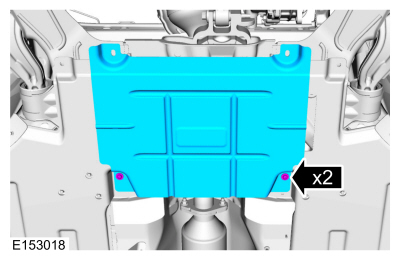 |
-
If equipped.
Remove the retainers and shields as needed.
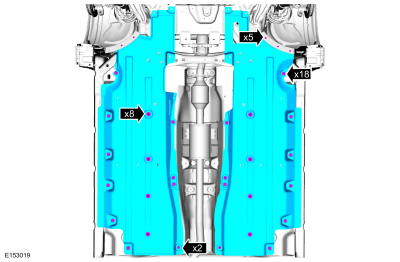 |
-
NOTE: The stabilizer bar links are designed with low friction ball joints that have a low breakaway torque.
NOTE: Use the hex-holding feature to prevent the ball stud from turning while removing or installing the stabilizer bar link nut.
On both sides.
Remove and discard the stabilizer bar link lower nut and position aside the stabilizer bar link.
Torque: 85 lb.ft (115 Nm)
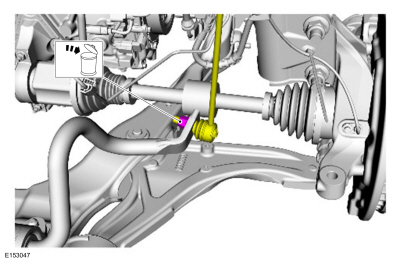 |
-
On both sides.
Remove and discard the front stabilizer bar bracket bolts.
Torque: 122 lb.ft (165 Nm)
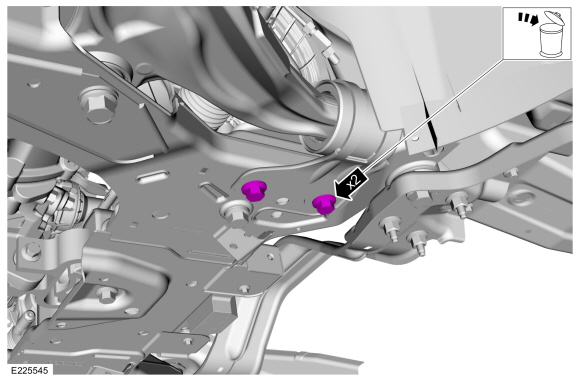 |
-
NOTE: The front stabilizer bar must be positioned towards the rear of the vehicle to gain access to the front stabilizer bar bushings.
Move the front stabilizer bar towards the rear of the vehicle.
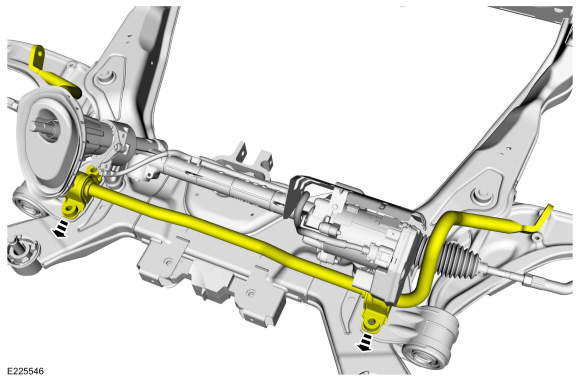 |
-
NOTICE: Do not use any lubrication on the stabilizer bar or the bushings or damage to the bushings may occur.
NOTE: Stabilizer bar bushings must be installed with slits facing the rear of the vehicle.
Remove the front stabilizer bar bushing brackets and the front stabilizer bar bushings.
 |
Installation
-
To install, reverse the removal procedure.
 Front Stabilizer Bar. Removal and Installation
Front Stabilizer Bar. Removal and Installation
Removal
NOTICE:
Suspension fasteners are critical parts that affect the
performance of vital components and systems. Failure of these fasteners
may result in major service expense...
 Front Stabilizer Bar Link. Removal and Installation
Front Stabilizer Bar Link. Removal and Installation
Removal
NOTICE:
Suspension fasteners are critical parts that affect the
performance of vital components and systems. Failure of these fasteners
may result in major service expense...
Other information:
Ford Fusion 2013–2020 Service Manual: All-Wheel Drive (AWD) Module. Removal and Installation
Removal Release the clips and remove the loadspace trim panel. Disconnect the AWD module electrical connector. Remove the AWD module push pin fasteners and the AWD module. Installation Install the AWD module and the push pin fasteners...
Ford Fusion 2013–2020 Owners Manual: Hilly Condition Usage. Switching Adaptive Cruise Control Off. Detection Issues
Hilly Condition Usage Select a lower gear when the system is active in situations such as prolonged downhill driving on steep grades, for example in mountainous areas. The system needs additional engine braking in these situations to reduce the load on the vehicle’s regular brake system to prevent it from overheating...
Categories
- Manuals Home
- 2nd Generation Ford Fusion Owners Manual
- 2nd Generation Ford Fusion Service Manual
- Engine - 1.5L EcoBoost (118kW/160PS) – I4
- Pre-Collision Assist (IF EQUIPPED)
- Main Control Valve Body. Removal and Installation
- New on site
- Most important about car
Fuel Quality
Choosing the Right Fuel

Your vehicle is designed to operate on regular unleaded gasoline with a minimum pump (R+M)/2 octane rating of 87.
